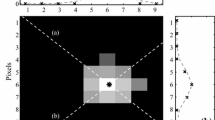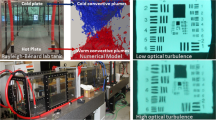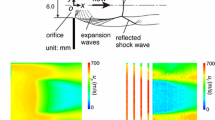Abstract
Velocity is a key parameter characterizing the movement of saltating particles. High-speed photography is an efficient method to record the velocity. But, manually determining the relevant information from these photographs is quite laborious. However, particle tracking velocimetry (PTV) can be used to measure the instantaneous velocity in fluids using tracer particles. The tracer particles have three basic features in fluids: similar movement patterns within a small region, a uniform particle distribution, and high particle density. Unfortunately, the saltation of sand particles in air is a stochastic process, and PTV has not yet been able to accurately determine the velocity field in a cloud of blowing sand. The aim of the present study was to develop an improved PTV technique to measure the downwind (horizontal) and vertical velocities of saltating sand. To demonstrate the feasibility of this new technique, we used it to investigate two-dimensional saltation of particles above a loose sand surface in a wind tunnel. We analyzed the properties of the saltating particles, including the probability distribution of particle velocity, variations in the mean velocity as a function of height, and particle turbulence. By automating much of the analysis, the improved PTV method can satisfy the requirement for a large sample size and can measure the velocity field of blowing sand more accurately than previously-used techniques. The results shed new light on the complicated mechanisms involved in sand saltation.
Similar content being viewed by others
References
Anderson R S, Haff P K. 1988. Simulation of aeolian saltation. Science, 241(4867): 820–823.
Anderson R S, Haff P K. 1991. Wind modification and bed response during saltation of sand in air. In: Barndorff-Nielsen O E, Willetts B B. Aeolian Grain Transport 1. Acta Mechanica Supplementum. Vienna: Springer, 21–51.
Baek S J, Lee S J. 1996. A new two-frame particle tracking algorithm using match probability. Experiments in Fluids, 22(1): 23–32.
Bagnold R A. 1941. The Physics of Blown Sand and Desert Dunes. New York: William Morrow, 265.
Chepil W S. 1945. Dynamics of wind erosion: I. Nature of movement of soil by wind. Soil Science, 60(4): 305–320.
Dong Z B, Liu X P, Li F, et al. 2002a. Impact-entrainment relationship in a saltating cloud. Earth Surface Processes and Landforms, 27(6): 641–658.
Dong Z B, Wang H T, Liu X P, et al. 2002b. Velocity profile of a sand cloud blowing over a gravel surface. Geomorphology, 45(3–4): 277–289.
Dong Z B, Liu X P, Wang X M, et al. 2004. Experimental investigation of the velocity of a sand cloud blowing over a sandy surface. Earth Surface Processes and Landforms, 29(3): 343–358.
Dong Z B, Qian G Q, Luo W Y, et al. 2006. Analysis of the mass flux profiles of an aeolian saltating cloud. Journal of Geophysical Research, 111(D16): D16111.
Dong Z B, Qian G Q, Luo W Y, et al. 2007. A wind tunnel simulation of the effects of stoss slope on the lee airflow pattern over a two-dimensional transverse dune. Journal of Geophysical Research, 112(F3): F03019.
Fu L T, BoT L, Gu H H, et al. 2013. Incident angle of saltating particles in wind-blown sand. PLoS ONE, 8(7): e67935.
Gonzalez R C, Woods R E, Eddins S L. 2009. Digital image processing using MATLAB (2nd ed.). Knoxville, TN: Gatesmark Publishing, 276–281.
Greeley R, Williams S H, Marshall J R. 1983. Velocities of windblown particles in saltation: Preliminary laboratory and field measurements. Developments in Sedimentology, 38: 133–148.
Hassan Y A, Canaan R E. 1991. Full-field bubbly flow velocity measurements using a multiframe particle tracking technique. Experiments in Fluids, 12(1–2): 49–60.
Hopwood J M, Scott W D. 1997. A mathematical model of saltation. Acta Mechanica, 124(1–4): 199–211.
Hunt J C R, Nalpanis P. 1985. Saltating and suspended particles over flat and sloping surfaces. In: Barndorff-Nielsen O E, Moller J T, Rasmussen K R, et al. Proceedings of the International Workshop on the Physics of Blown Sand. Aarhus, Denmark: University of Aarhus, 37–66.
Keane R D, Adrian R J, Zhang Y. 1995. Super-resolution particle imaging velocimetry. Measurement Science and Technology, 6(6): 754–768.
Kobayashi T, Saga T, Haeno T, et al. 1991. Development of a real-time velocity measurement system for high Reynolds fluid flow using a digital image processing design. In: Khalighia B. Experimental and Numerical Flow Visualization. New York: ASME, 9–14.
Liu X P, Dong Z B. 2004. Experimental investigation of the concentration profile of a blowing sand cloud. Geomorphology, 60(3–4): 371–381.
Luo W Y, Dong Z B, Qian G Q, et al. 2012. Wind tunnel simulation of the three-dimensional airflow patterns behind cuboid obstacles at different angles of wind incidence, and their significance for the formation of sand shadows. Geomorphology, 139–140: 258–270.
Maas H G, Gruen A, Papantoniou D. 1993. Particle tracking velocimetry in three-dimensional flows: Part 1. Photogrammetric determination of particle coordinates. Experiments in Fluids, 15(2): 133–146.
Ohmi K, Li H Y. 2000. Particle-tracking velocimetry with new algorithms. Measurement Science and Technology, 11(6): 603–616.
Owen P, Gillette D. 1985. Wind tunnel constraint on saltation. In: Barndorff-Nielsen O E, Moller J T, Rasmussen K R, et al. Proceedings of the International Workshop on the Physics of Blown Sand. Aarhus, Denmark: University of Aarhus, 253–270.
Qu J W, Murai Y, Yamamoto F. 2004. Simultaneous PIV/PTV measurements of bubble and particle phases in gas-liquid two-phase flow based on image separation and reconstruction. Journal of Hydrodynamics, 16(6): 756–766.
Rasmussen K R, Mikkelsen H E. 1991. Wind tunnel observations of aeolian transport rates. In: Barndorff-Nielsen O E, Willetts B B. Aeolian Grain Transport 1. Acta Mechanica Supplementum. Vienna: Springer, 135–144.
Rice M A, Willetts B B, Mc Ewan I K. 1995. An experimental study of multiple grain-size ejecta produced by collisions of saltating grains with a flat bed. Sedimentology, 42(4): 695–706.
Rice M A, Willetts B B, McEwan I K. 1996. Observations of collisions of saltating grains with a granular bed from high-speed cine-film. Sedimentology, 43(1): 21–31.
Saffman P. 1965. The lift on a small sphere in a slow shear flow. Journal of Fluid Mechanics, 22(2): 385–400.
Sørensen M, McEwan I K. 1996. On the effect of mid-air collisions on aeolian saltation. Sedimentology, 43(1): 65–76.
Stitou A, Riethmuller M L. 2001. Extension of PIV to super resolution using PTV. Measurement Science and Technology, 12(9): 1398–1403.
Tong D, Huang N. 2012. Numerical simulation of saltating particles in atmospheric boundary layer over flat bed and sand ripples, Journal of Geophysical Research, 117: D16205.
White B R, Schulz J C. 1977. Magnus effect in saltation. Journal of Fluid Mechanics, 81(3): 497–512.
White B R. 1985. The dynamics of particle motion in saltation. In: Barndorff-Nielsen O E, Moller J T, Rasmussen K R, et al. Proceedings of the International Workshop on the Physics of Blown Sand: I. modeling concepts. Aarhus, Denmark: University of Aarhus, 101–140.
White B R, Mounla H. 1991. An experimental study of Froude number effect on wind-tunnel saltation. In: Barndorff-Nielsen O E, Willetts B B. Aeolian Grain Transport 1. Acta Mechanica Supplementum. Vienna: Springer, 145–157.
Willetts B B, Rice M A. 1985. Inter-saltation collisions. In: Barndorff-Nielsen O E, Moller J T, Rasmussen K R, et al. Proceedings of the International Workshop on the Physics of Blown Sand. Aarhus, Denmark: University of Aarhus, 83–100.
Willetts B B, Rice M A. 1986. Collisions in aeolian saltation. Acta Mechanica, 63(1–4): 255–265.
Willetts B B, Mc Ewan I K, Rice M A. 1991. Initiation of motion of quartz sand grains. In: Barndorff-Nielsen O E, Willetts B B. Aeolian Grain Transport 1. Acta Mechanica Supplementum. Vienna: Springer, 123–134.
Williams J J, Butterfield G R, Clark D G. 1994. Aerodynamic entrainment threshold: Effects of boundary layer flow conditions. Sedimentology, 41(2): 309–328.
Yang P, Dong Z B, Qian G Q, et al. 2007. Height profile of the mean velocity of an aeolian saltating cloud: Wind tunnel measurements by Particle Image Velocimetry. Geomorphology, 89(3–4): 320–334.
Zhang W, Wang Y, Lee S J. 2007. Two-phase measurements of wind and saltating sand in an atmospheric boundary layer. Geomorphology, 88: 109–119.
Zhang W, Wang Y, Lee S J. 2008. Simultaneous PIV and PTV measurements of wind and sand particle velocities. Experiments in Fluids, 45: 241–256.
Zheng X J, Huang N, Zhou Y H. 2004. Advances in investigation on electrification of wind-blown sands and its effects. Advances in Mechanics, 34(1): 77–86. (in Chinese)
Zou X Y, Zhu J J, Dong G R, et al. 1992. The distribution function of vertical lift-off velocity in an aeolian saltating cloud. Chinese Science Bulletin, 37(23): 2175–2177. (in Chinese)
Zou X Y, Wang Z L, Hao Q Z, et al. 2001. The distribution of velocity and energy of saltating sand grains in a wind tunnel. Geomorphology, 36(3–4): 155–165.
Acknowledgments
This work was funded by the Young Talent Fund of University Association for Science and Technology in Shaanxi, China (20170303), the National Science Basic Research Plan in Shaanxi Province of China (2017JQ6080), and the Talent Development Project of Weinan Normal University, China (16ZRRC02).
Author information
Authors and Affiliations
Corresponding author
Rights and permissions
About this article
Cite this article
Jiang, C., Dong, Z. & Wang, X. An improved particle tracking velocimetry (PTV) technique to evaluate the velocity field of saltating particles. J. Arid Land 9, 727–742 (2017). https://doi.org/10.1007/s40333-017-0030-6
Received:
Revised:
Accepted:
Published:
Issue Date:
DOI: https://doi.org/10.1007/s40333-017-0030-6




